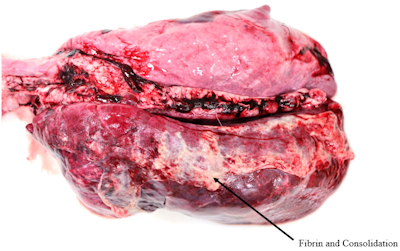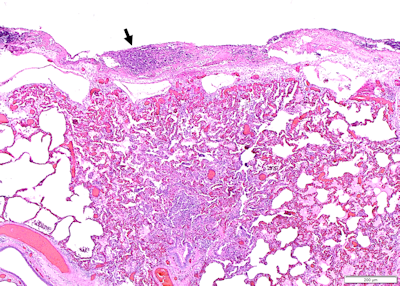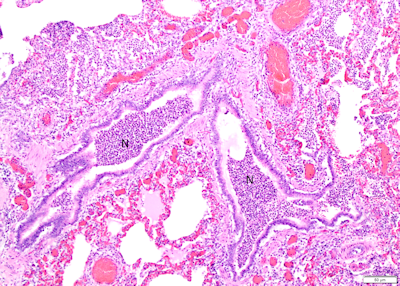
Porcine Pleuropneumonia
By Drs. Giselle Cino, Jonathon Sago, Jamie Henningson, Lalitha Peddireddi, and Megan Niederwerder
Actinobacillus pleuropneumoniae (APP) is the cause of porcine pleuropneumonia. Infections with APP result in a severe, and often fatal, pneumonia that usually affects growing pigs between the ages of 6 weeks and 5 months.
History
A herd of 150 feeder pigs experienced approximately 40 deaths over the span of 1 week in early July. The pigs had been vaccinated for Porcine Circovirus, Mycoplasma hyopneumoniae, Bordetella bronchiseptica, Erysipelothrix rhusiopathiae, and Pasteurella multocida Types A and D at 2 weeks of age.
Clinical Signs
Most of the affected pigs died suddenly with minimal to no clinical signs. Some pigs were reported to have respiratory signs, such as open mouth breathing and coughing.
Diagnostics
One affected pig from this herd was submitted for postmortem examination. On gross necropsy evaluation, 100% of the left lung lobes and approximately 25% of the right lung lobes were covered in fibrin, diffusely consolidated, and necrotic (Figures 1 and 2). Histopathology revealed severe fibrinosuppurative pneumonia and pleuritis (Figure 3; black arrow pointing at the pleura). Microscopic lung lesions included edema and neutrophilic infiltration of the bronchi (Figure 4; N indicating neutrophils). These lesions are characteristic of APP infection. Diagnostic confirmation of APP was performed through bacterial culture and APP PCR. PCR testing for porcine reproductive and respiratory syndrome virus (PRRSV) was negative.
Take Home Message: Porcine pleuropneumonia caused by Actinobacillus pleuropneumoniae is well controlled in most U.S. swine through APP elimination programs. However, disease outbreaks still occasionally occur in commercial herds and can cause significant losses due to high morbidity and mortality. APP lung lesions may be unilateral or bilateral. For detection of APP, it is important to collect samples from the affected areas (i.e., lung sections from the affected half if unilateral). APP should be considered as a possible cause of acute, severe respiratory disease or sudden death in grow-finish pigs.
Figure 1 |
Figure 2 |
Figure 3 |
Figure 4 |




